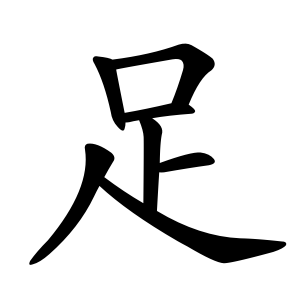足
- foot, leg;
It also carries meanings related to “to be enough” or “to be satisfied,” as in the word 만족 (滿足), meaning “satisfaction” or “to be satisfied.”
Etymology
The character 足 (족) broadly refers to the entire foot, but more specifically, it can denote the area below the ankle (around the ankle bone).
The 口 part represents the area below the knee, and 止 depicts the foot itself, so the overall shape symbolizes the region from the knee to the front of the foot.
Its meaning extends to include animal feet, the base of a vessel or container, and even the foot of a mountain. Additionally, it conveys meanings related to sufficiency or being enough (충족하다, 족하다).
Usage in Korean
When used as a radical, it generally relates to the lower leg, foot movements, or the state of the foot.
When placed on the left side (좌변) of a character, it transforms into the variant form 𧾷.
Examples of characters using this radical include:
路 (길 로, "road")
跡 (발자취 적, "trace, footprint")
跳 (뛸 도, "to jump")
躍 (뛸 약, "to leap")
踏 (밟을 답, "to step on")
蹴 (찰 축, "to kick")
Interestingly, many characters with this radical have meanings related to actions like kicking, stepping, or trampling, which often carry negative or forceful connotations.
Alternative forms
Characters with 足
Words that derived from 足
- 口卜人 (RYO)
- ⿱ 口 龰
